Health Service Plan: Aged Care in South Western Sydney
VerifiedAdded on 2023/06/03
|21
|4063
|281
Report
AI Summary
This health service plan focuses on the geriatric health care sector within the South Western Sydney Local Health District (SWSLHD), addressing the increasing healthcare needs of the aging population. It provides an environmental scan, demographic analysis, and population projections, highlighting the growing demand for aged care services. The report examines determinants of health, burden of disease, and mortality data to assess needs and current service profiles, including facilities and partnerships. It analyzes catchment areas, identifies service gaps, and proposes future service models, goals, and strategies. The plan emphasizes the need for improved aged care teams, equitable healthcare for Aboriginal elderly individuals, and integrated preventive health strategies, culminating in recommendations for enhancing geriatric care and rehabilitation services within the SWSLHD.
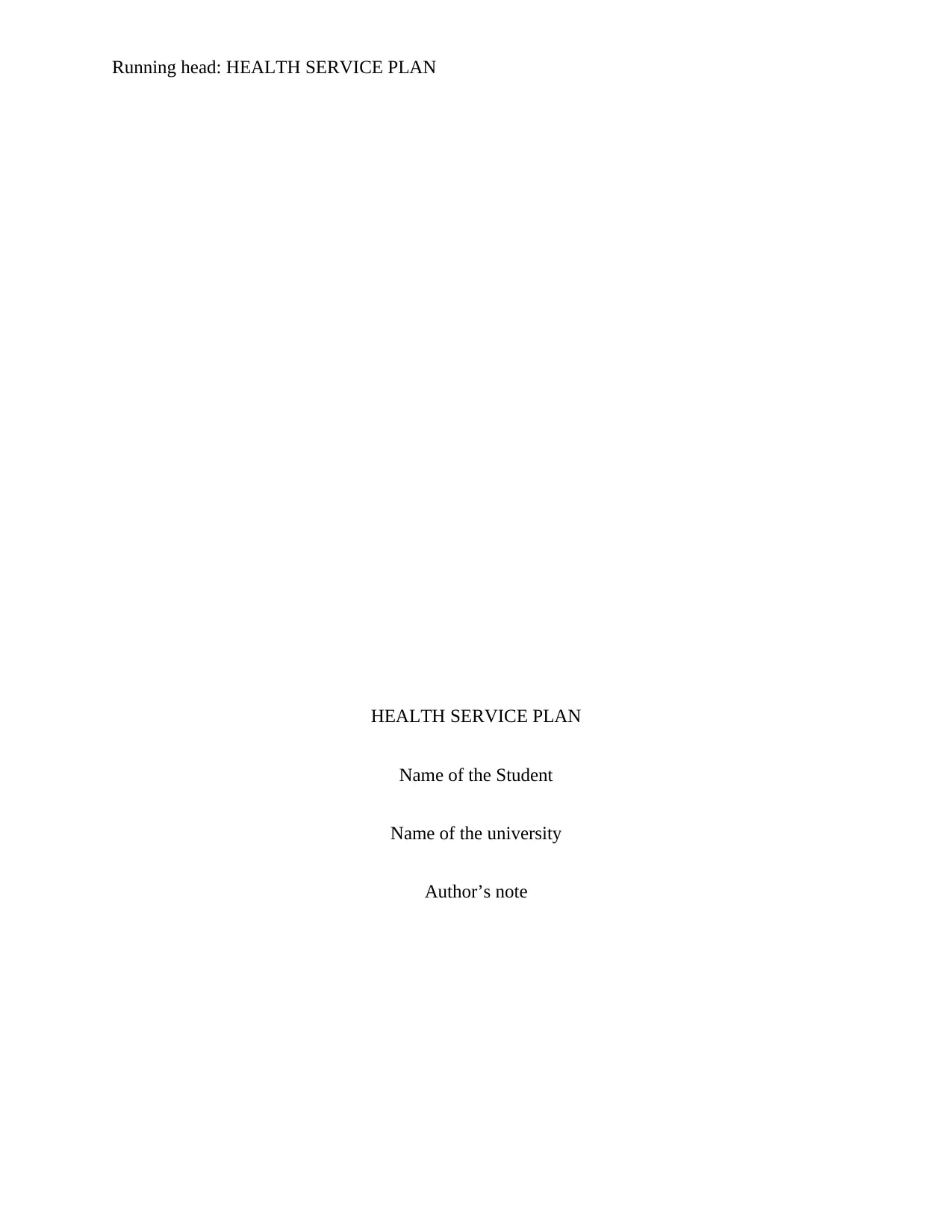
Running head: HEALTH SERVICE PLAN
HEALTH SERVICE PLAN
Name of the Student
Name of the university
Author’s note
HEALTH SERVICE PLAN
Name of the Student
Name of the university
Author’s note
Paraphrase This Document
Need a fresh take? Get an instant paraphrase of this document with our AI Paraphraser
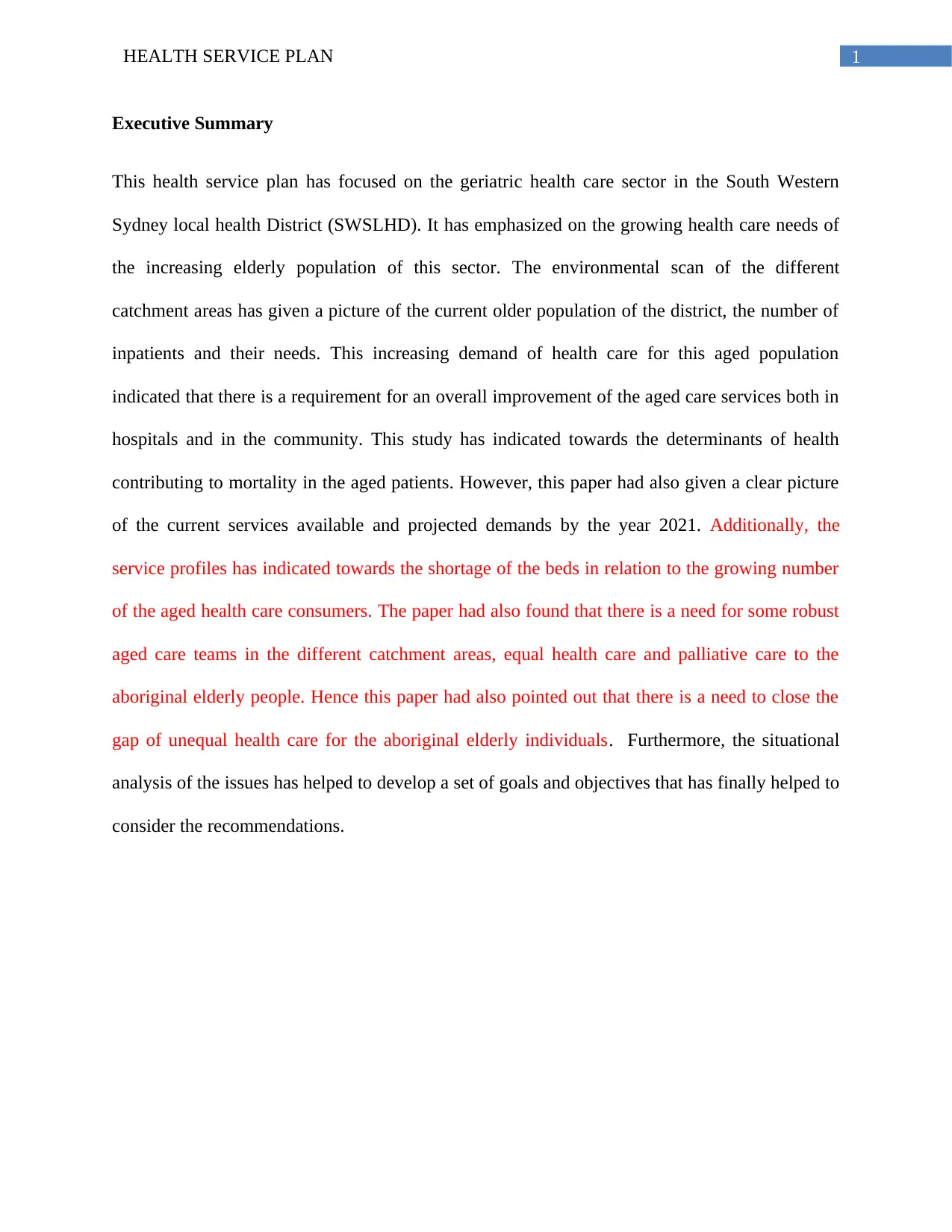
1HEALTH SERVICE PLAN
Executive Summary
This health service plan has focused on the geriatric health care sector in the South Western
Sydney local health District (SWSLHD). It has emphasized on the growing health care needs of
the increasing elderly population of this sector. The environmental scan of the different
catchment areas has given a picture of the current older population of the district, the number of
inpatients and their needs. This increasing demand of health care for this aged population
indicated that there is a requirement for an overall improvement of the aged care services both in
hospitals and in the community. This study has indicated towards the determinants of health
contributing to mortality in the aged patients. However, this paper had also given a clear picture
of the current services available and projected demands by the year 2021. Additionally, the
service profiles has indicated towards the shortage of the beds in relation to the growing number
of the aged health care consumers. The paper had also found that there is a need for some robust
aged care teams in the different catchment areas, equal health care and palliative care to the
aboriginal elderly people. Hence this paper had also pointed out that there is a need to close the
gap of unequal health care for the aboriginal elderly individuals. Furthermore, the situational
analysis of the issues has helped to develop a set of goals and objectives that has finally helped to
consider the recommendations.
Executive Summary
This health service plan has focused on the geriatric health care sector in the South Western
Sydney local health District (SWSLHD). It has emphasized on the growing health care needs of
the increasing elderly population of this sector. The environmental scan of the different
catchment areas has given a picture of the current older population of the district, the number of
inpatients and their needs. This increasing demand of health care for this aged population
indicated that there is a requirement for an overall improvement of the aged care services both in
hospitals and in the community. This study has indicated towards the determinants of health
contributing to mortality in the aged patients. However, this paper had also given a clear picture
of the current services available and projected demands by the year 2021. Additionally, the
service profiles has indicated towards the shortage of the beds in relation to the growing number
of the aged health care consumers. The paper had also found that there is a need for some robust
aged care teams in the different catchment areas, equal health care and palliative care to the
aboriginal elderly people. Hence this paper had also pointed out that there is a need to close the
gap of unequal health care for the aboriginal elderly individuals. Furthermore, the situational
analysis of the issues has helped to develop a set of goals and objectives that has finally helped to
consider the recommendations.
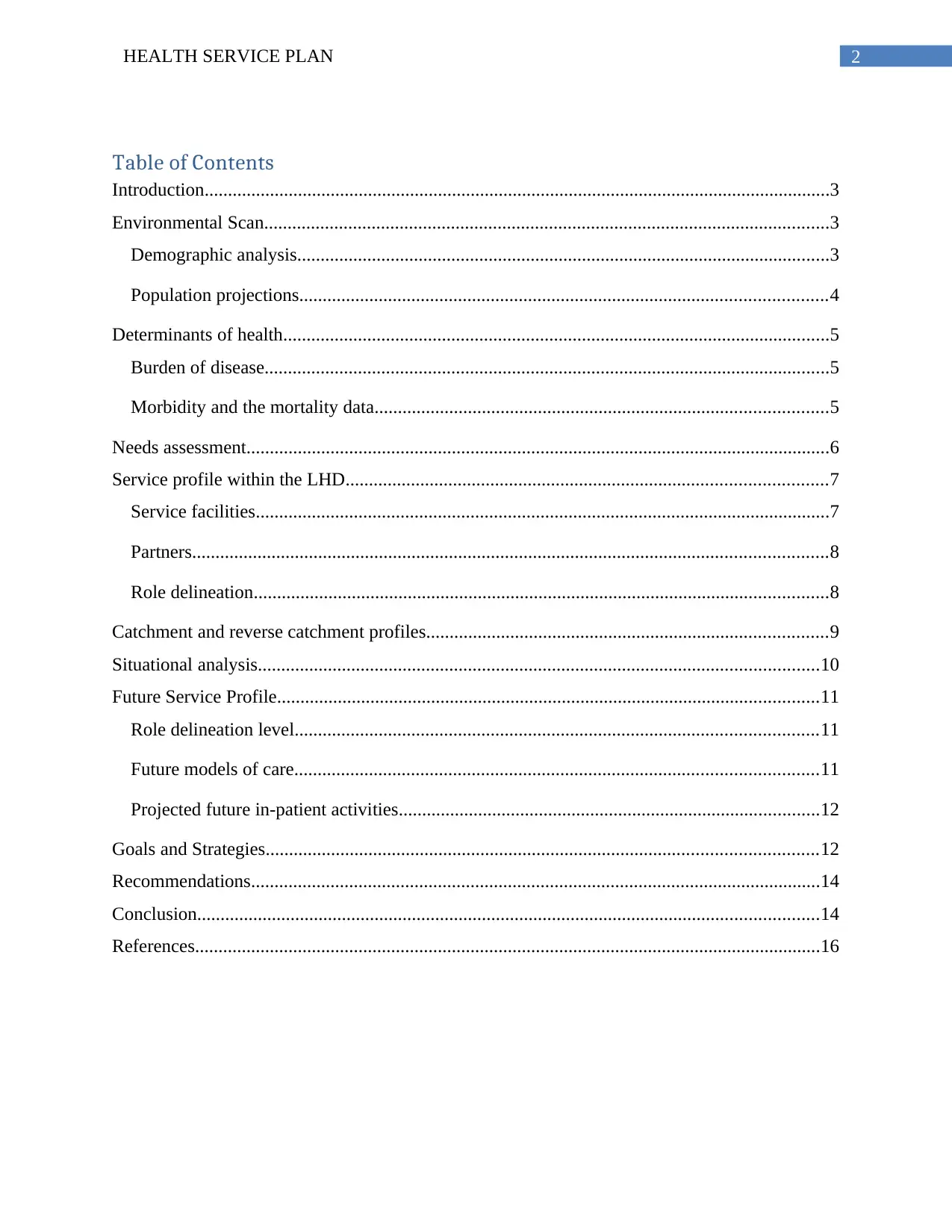
2HEALTH SERVICE PLAN
Table of Contents
Introduction......................................................................................................................................3
Environmental Scan.........................................................................................................................3
Demographic analysis..................................................................................................................3
Population projections.................................................................................................................4
Determinants of health.....................................................................................................................5
Burden of disease.........................................................................................................................5
Morbidity and the mortality data.................................................................................................5
Needs assessment.............................................................................................................................6
Service profile within the LHD.......................................................................................................7
Service facilities...........................................................................................................................7
Partners........................................................................................................................................8
Role delineation...........................................................................................................................8
Catchment and reverse catchment profiles......................................................................................9
Situational analysis........................................................................................................................10
Future Service Profile....................................................................................................................11
Role delineation level................................................................................................................11
Future models of care................................................................................................................11
Projected future in-patient activities..........................................................................................12
Goals and Strategies......................................................................................................................12
Recommendations..........................................................................................................................14
Conclusion.....................................................................................................................................14
References......................................................................................................................................16
Table of Contents
Introduction......................................................................................................................................3
Environmental Scan.........................................................................................................................3
Demographic analysis..................................................................................................................3
Population projections.................................................................................................................4
Determinants of health.....................................................................................................................5
Burden of disease.........................................................................................................................5
Morbidity and the mortality data.................................................................................................5
Needs assessment.............................................................................................................................6
Service profile within the LHD.......................................................................................................7
Service facilities...........................................................................................................................7
Partners........................................................................................................................................8
Role delineation...........................................................................................................................8
Catchment and reverse catchment profiles......................................................................................9
Situational analysis........................................................................................................................10
Future Service Profile....................................................................................................................11
Role delineation level................................................................................................................11
Future models of care................................................................................................................11
Projected future in-patient activities..........................................................................................12
Goals and Strategies......................................................................................................................12
Recommendations..........................................................................................................................14
Conclusion.....................................................................................................................................14
References......................................................................................................................................16
⊘ This is a preview!⊘
Do you want full access?
Subscribe today to unlock all pages.

Trusted by 1+ million students worldwide
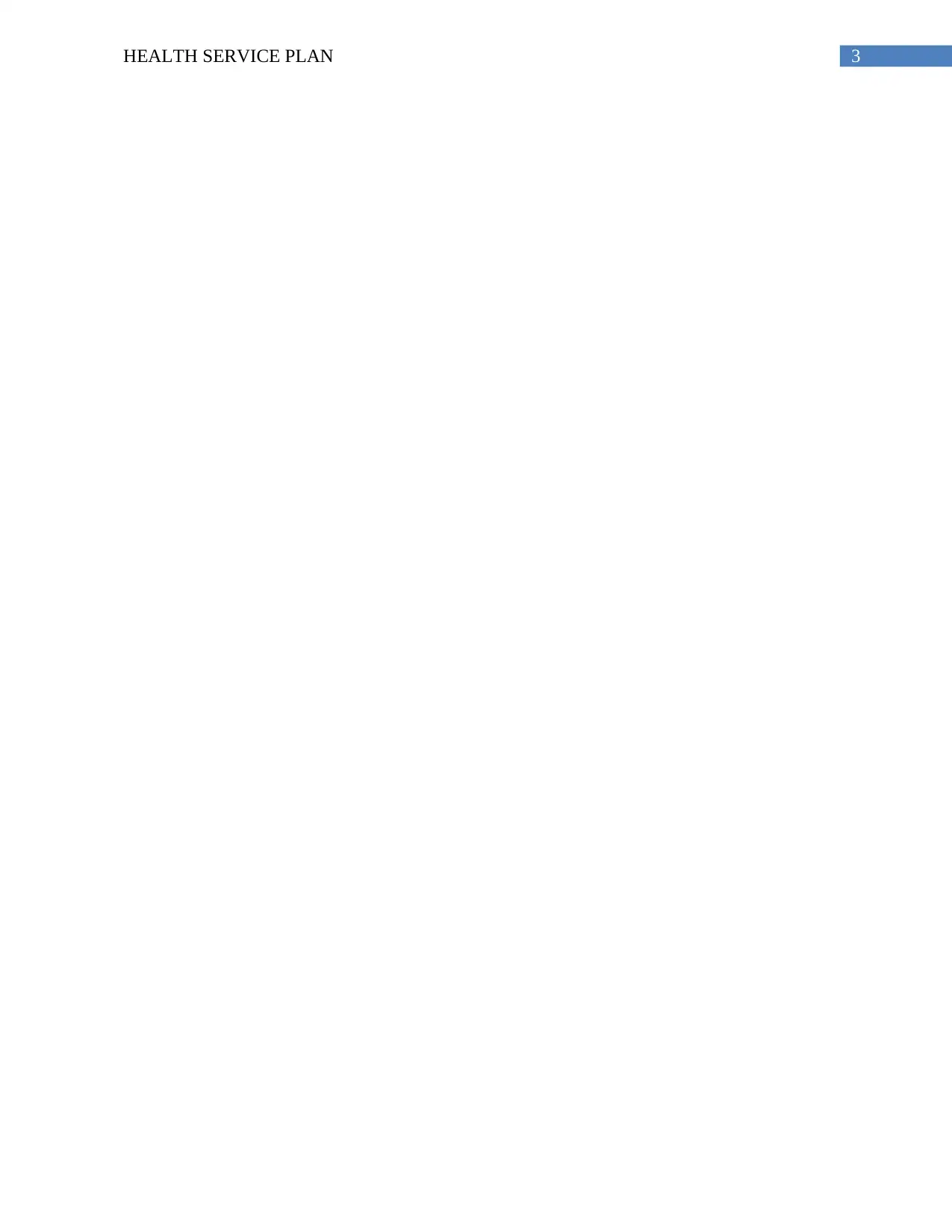
3HEALTH SERVICE PLAN
Paraphrase This Document
Need a fresh take? Get an instant paraphrase of this document with our AI Paraphraser
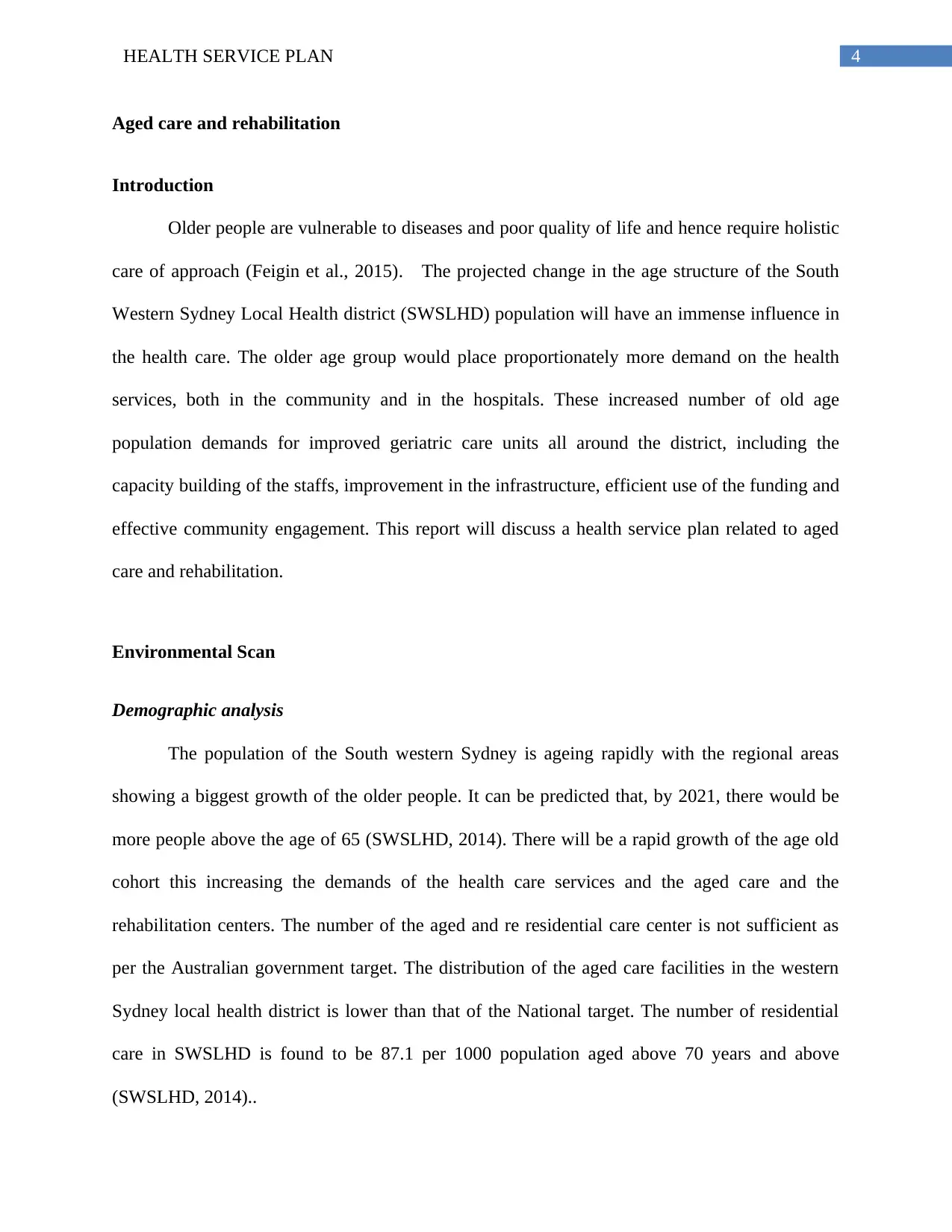
4HEALTH SERVICE PLAN
Aged care and rehabilitation
Introduction
Older people are vulnerable to diseases and poor quality of life and hence require holistic
care of approach (Feigin et al., 2015). The projected change in the age structure of the South
Western Sydney Local Health district (SWSLHD) population will have an immense influence in
the health care. The older age group would place proportionately more demand on the health
services, both in the community and in the hospitals. These increased number of old age
population demands for improved geriatric care units all around the district, including the
capacity building of the staffs, improvement in the infrastructure, efficient use of the funding and
effective community engagement. This report will discuss a health service plan related to aged
care and rehabilitation.
Environmental Scan
Demographic analysis
The population of the South western Sydney is ageing rapidly with the regional areas
showing a biggest growth of the older people. It can be predicted that, by 2021, there would be
more people above the age of 65 (SWSLHD, 2014). There will be a rapid growth of the age old
cohort this increasing the demands of the health care services and the aged care and the
rehabilitation centers. The number of the aged and re residential care center is not sufficient as
per the Australian government target. The distribution of the aged care facilities in the western
Sydney local health district is lower than that of the National target. The number of residential
care in SWSLHD is found to be 87.1 per 1000 population aged above 70 years and above
(SWSLHD, 2014)..
Aged care and rehabilitation
Introduction
Older people are vulnerable to diseases and poor quality of life and hence require holistic
care of approach (Feigin et al., 2015). The projected change in the age structure of the South
Western Sydney Local Health district (SWSLHD) population will have an immense influence in
the health care. The older age group would place proportionately more demand on the health
services, both in the community and in the hospitals. These increased number of old age
population demands for improved geriatric care units all around the district, including the
capacity building of the staffs, improvement in the infrastructure, efficient use of the funding and
effective community engagement. This report will discuss a health service plan related to aged
care and rehabilitation.
Environmental Scan
Demographic analysis
The population of the South western Sydney is ageing rapidly with the regional areas
showing a biggest growth of the older people. It can be predicted that, by 2021, there would be
more people above the age of 65 (SWSLHD, 2014). There will be a rapid growth of the age old
cohort this increasing the demands of the health care services and the aged care and the
rehabilitation centers. The number of the aged and re residential care center is not sufficient as
per the Australian government target. The distribution of the aged care facilities in the western
Sydney local health district is lower than that of the National target. The number of residential
care in SWSLHD is found to be 87.1 per 1000 population aged above 70 years and above
(SWSLHD, 2014)..
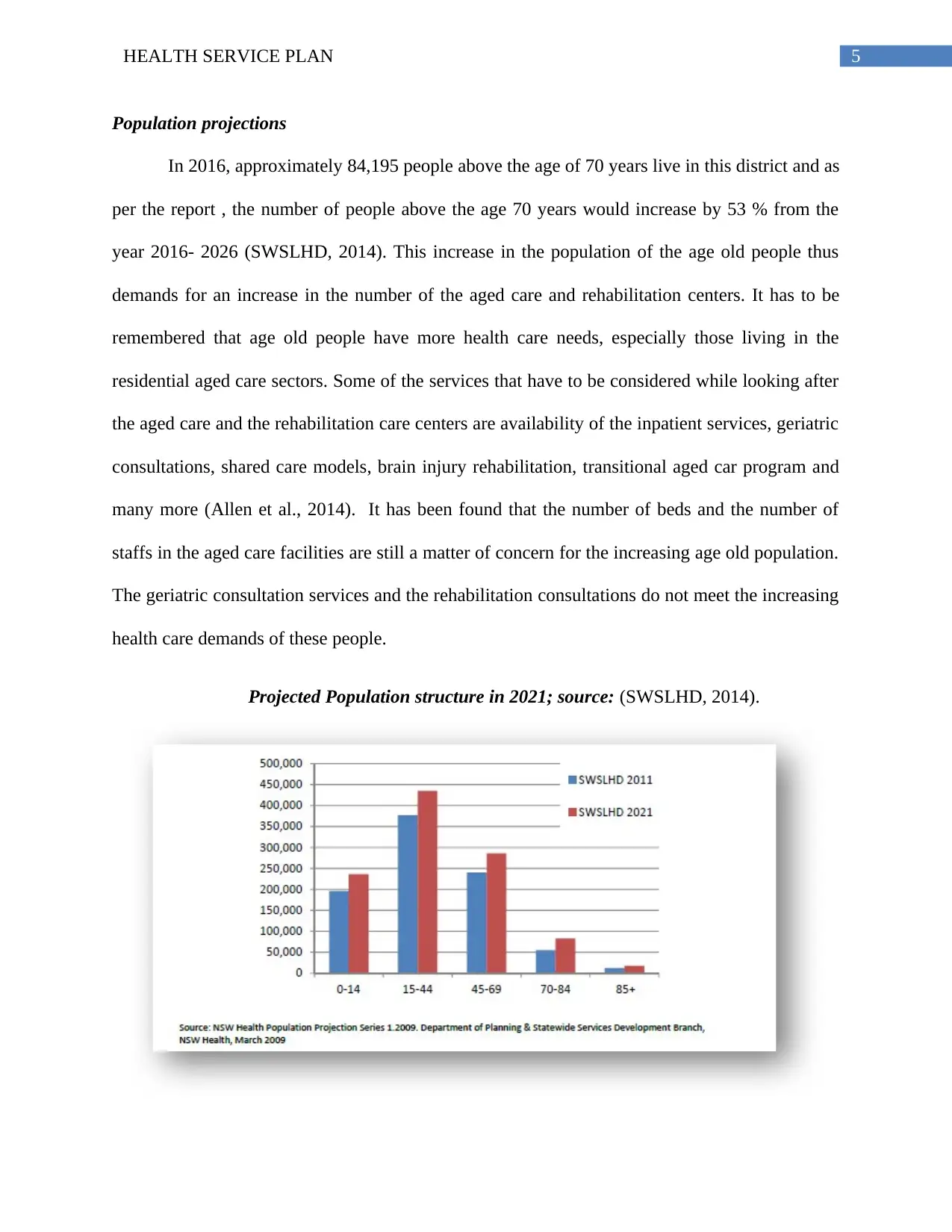
5HEALTH SERVICE PLAN
Population projections
In 2016, approximately 84,195 people above the age of 70 years live in this district and as
per the report , the number of people above the age 70 years would increase by 53 % from the
year 2016- 2026 (SWSLHD, 2014). This increase in the population of the age old people thus
demands for an increase in the number of the aged care and rehabilitation centers. It has to be
remembered that age old people have more health care needs, especially those living in the
residential aged care sectors. Some of the services that have to be considered while looking after
the aged care and the rehabilitation care centers are availability of the inpatient services, geriatric
consultations, shared care models, brain injury rehabilitation, transitional aged car program and
many more (Allen et al., 2014). It has been found that the number of beds and the number of
staffs in the aged care facilities are still a matter of concern for the increasing age old population.
The geriatric consultation services and the rehabilitation consultations do not meet the increasing
health care demands of these people.
Projected Population structure in 2021; source: (SWSLHD, 2014).
Population projections
In 2016, approximately 84,195 people above the age of 70 years live in this district and as
per the report , the number of people above the age 70 years would increase by 53 % from the
year 2016- 2026 (SWSLHD, 2014). This increase in the population of the age old people thus
demands for an increase in the number of the aged care and rehabilitation centers. It has to be
remembered that age old people have more health care needs, especially those living in the
residential aged care sectors. Some of the services that have to be considered while looking after
the aged care and the rehabilitation care centers are availability of the inpatient services, geriatric
consultations, shared care models, brain injury rehabilitation, transitional aged car program and
many more (Allen et al., 2014). It has been found that the number of beds and the number of
staffs in the aged care facilities are still a matter of concern for the increasing age old population.
The geriatric consultation services and the rehabilitation consultations do not meet the increasing
health care demands of these people.
Projected Population structure in 2021; source: (SWSLHD, 2014).
⊘ This is a preview!⊘
Do you want full access?
Subscribe today to unlock all pages.

Trusted by 1+ million students worldwide
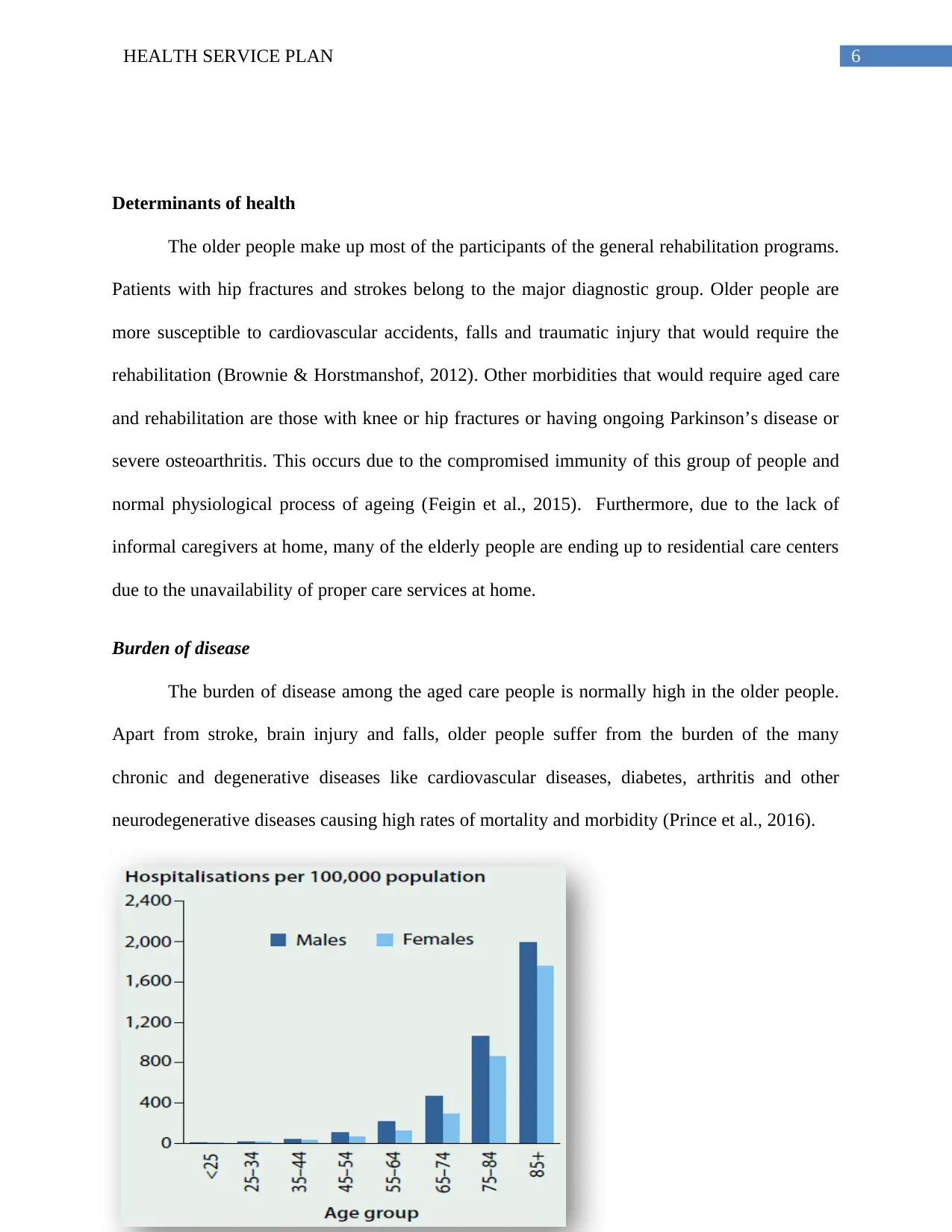
6HEALTH SERVICE PLAN
Determinants of health
The older people make up most of the participants of the general rehabilitation programs.
Patients with hip fractures and strokes belong to the major diagnostic group. Older people are
more susceptible to cardiovascular accidents, falls and traumatic injury that would require the
rehabilitation (Brownie & Horstmanshof, 2012). Other morbidities that would require aged care
and rehabilitation are those with knee or hip fractures or having ongoing Parkinson’s disease or
severe osteoarthritis. This occurs due to the compromised immunity of this group of people and
normal physiological process of ageing (Feigin et al., 2015). Furthermore, due to the lack of
informal caregivers at home, many of the elderly people are ending up to residential care centers
due to the unavailability of proper care services at home.
Burden of disease
The burden of disease among the aged care people is normally high in the older people.
Apart from stroke, brain injury and falls, older people suffer from the burden of the many
chronic and degenerative diseases like cardiovascular diseases, diabetes, arthritis and other
neurodegenerative diseases causing high rates of mortality and morbidity (Prince et al., 2016).
Determinants of health
The older people make up most of the participants of the general rehabilitation programs.
Patients with hip fractures and strokes belong to the major diagnostic group. Older people are
more susceptible to cardiovascular accidents, falls and traumatic injury that would require the
rehabilitation (Brownie & Horstmanshof, 2012). Other morbidities that would require aged care
and rehabilitation are those with knee or hip fractures or having ongoing Parkinson’s disease or
severe osteoarthritis. This occurs due to the compromised immunity of this group of people and
normal physiological process of ageing (Feigin et al., 2015). Furthermore, due to the lack of
informal caregivers at home, many of the elderly people are ending up to residential care centers
due to the unavailability of proper care services at home.
Burden of disease
The burden of disease among the aged care people is normally high in the older people.
Apart from stroke, brain injury and falls, older people suffer from the burden of the many
chronic and degenerative diseases like cardiovascular diseases, diabetes, arthritis and other
neurodegenerative diseases causing high rates of mortality and morbidity (Prince et al., 2016).
Paraphrase This Document
Need a fresh take? Get an instant paraphrase of this document with our AI Paraphraser
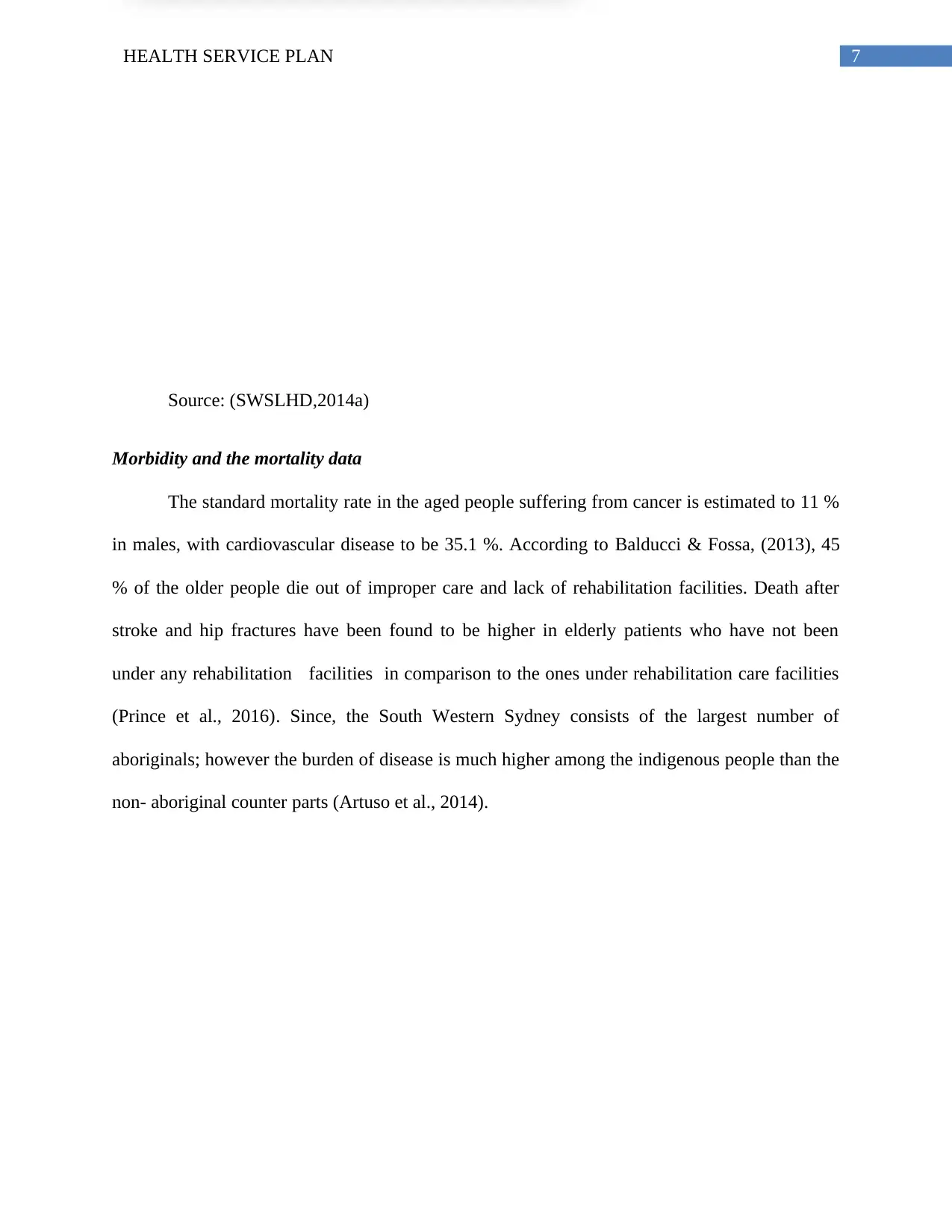
7HEALTH SERVICE PLAN
Source: (SWSLHD,2014a)
Morbidity and the mortality data
The standard mortality rate in the aged people suffering from cancer is estimated to 11 %
in males, with cardiovascular disease to be 35.1 %. According to Balducci & Fossa, (2013), 45
% of the older people die out of improper care and lack of rehabilitation facilities. Death after
stroke and hip fractures have been found to be higher in elderly patients who have not been
under any rehabilitation facilities in comparison to the ones under rehabilitation care facilities
(Prince et al., 2016). Since, the South Western Sydney consists of the largest number of
aboriginals; however the burden of disease is much higher among the indigenous people than the
non- aboriginal counter parts (Artuso et al., 2014).
Source: (SWSLHD,2014a)
Morbidity and the mortality data
The standard mortality rate in the aged people suffering from cancer is estimated to 11 %
in males, with cardiovascular disease to be 35.1 %. According to Balducci & Fossa, (2013), 45
% of the older people die out of improper care and lack of rehabilitation facilities. Death after
stroke and hip fractures have been found to be higher in elderly patients who have not been
under any rehabilitation facilities in comparison to the ones under rehabilitation care facilities
(Prince et al., 2016). Since, the South Western Sydney consists of the largest number of
aboriginals; however the burden of disease is much higher among the indigenous people than the
non- aboriginal counter parts (Artuso et al., 2014).
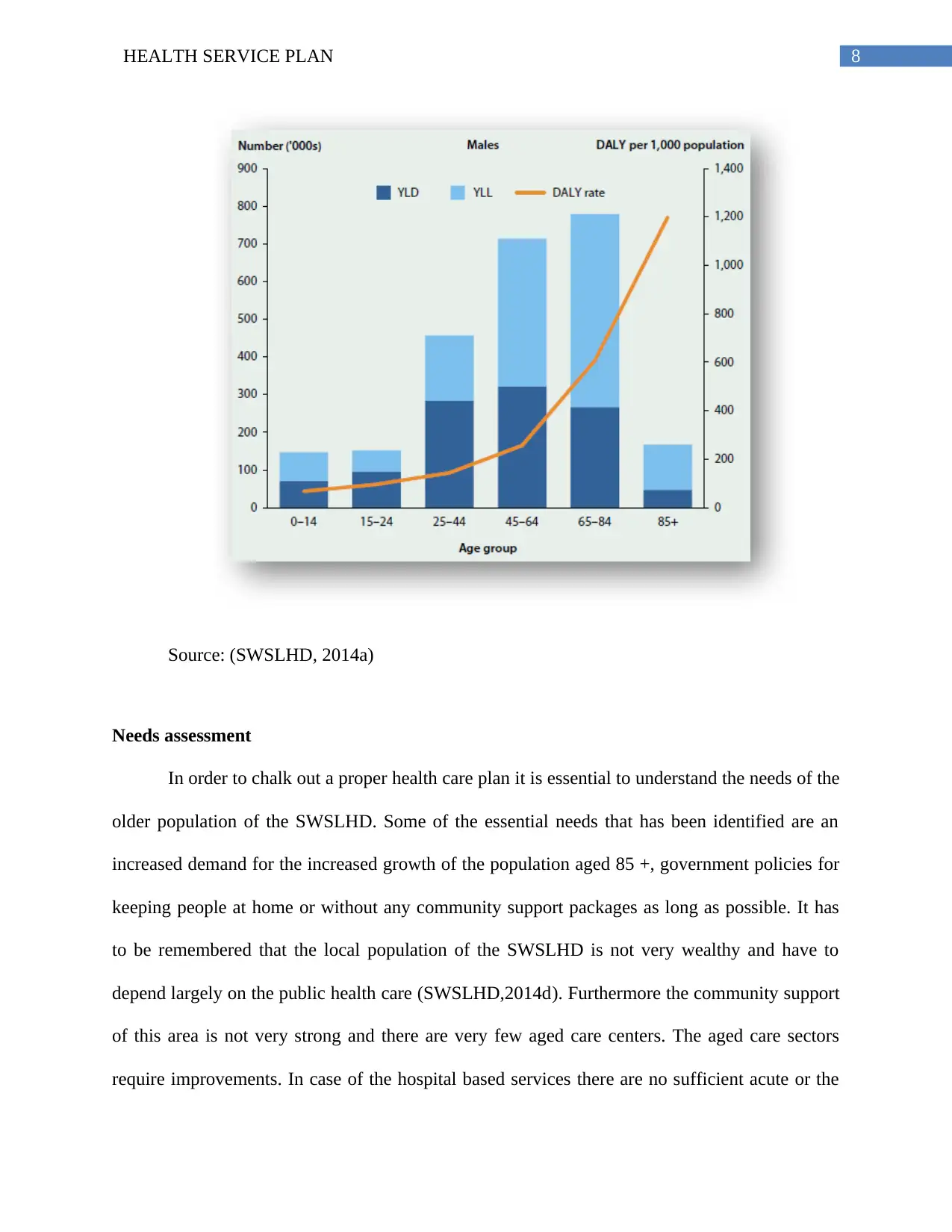
8HEALTH SERVICE PLAN
Source: (SWSLHD, 2014a)
Needs assessment
In order to chalk out a proper health care plan it is essential to understand the needs of the
older population of the SWSLHD. Some of the essential needs that has been identified are an
increased demand for the increased growth of the population aged 85 +, government policies for
keeping people at home or without any community support packages as long as possible. It has
to be remembered that the local population of the SWSLHD is not very wealthy and have to
depend largely on the public health care (SWSLHD,2014d). Furthermore the community support
of this area is not very strong and there are very few aged care centers. The aged care sectors
require improvements. In case of the hospital based services there are no sufficient acute or the
Source: (SWSLHD, 2014a)
Needs assessment
In order to chalk out a proper health care plan it is essential to understand the needs of the
older population of the SWSLHD. Some of the essential needs that has been identified are an
increased demand for the increased growth of the population aged 85 +, government policies for
keeping people at home or without any community support packages as long as possible. It has
to be remembered that the local population of the SWSLHD is not very wealthy and have to
depend largely on the public health care (SWSLHD,2014d). Furthermore the community support
of this area is not very strong and there are very few aged care centers. The aged care sectors
require improvements. In case of the hospital based services there are no sufficient acute or the
⊘ This is a preview!⊘
Do you want full access?
Subscribe today to unlock all pages.

Trusted by 1+ million students worldwide
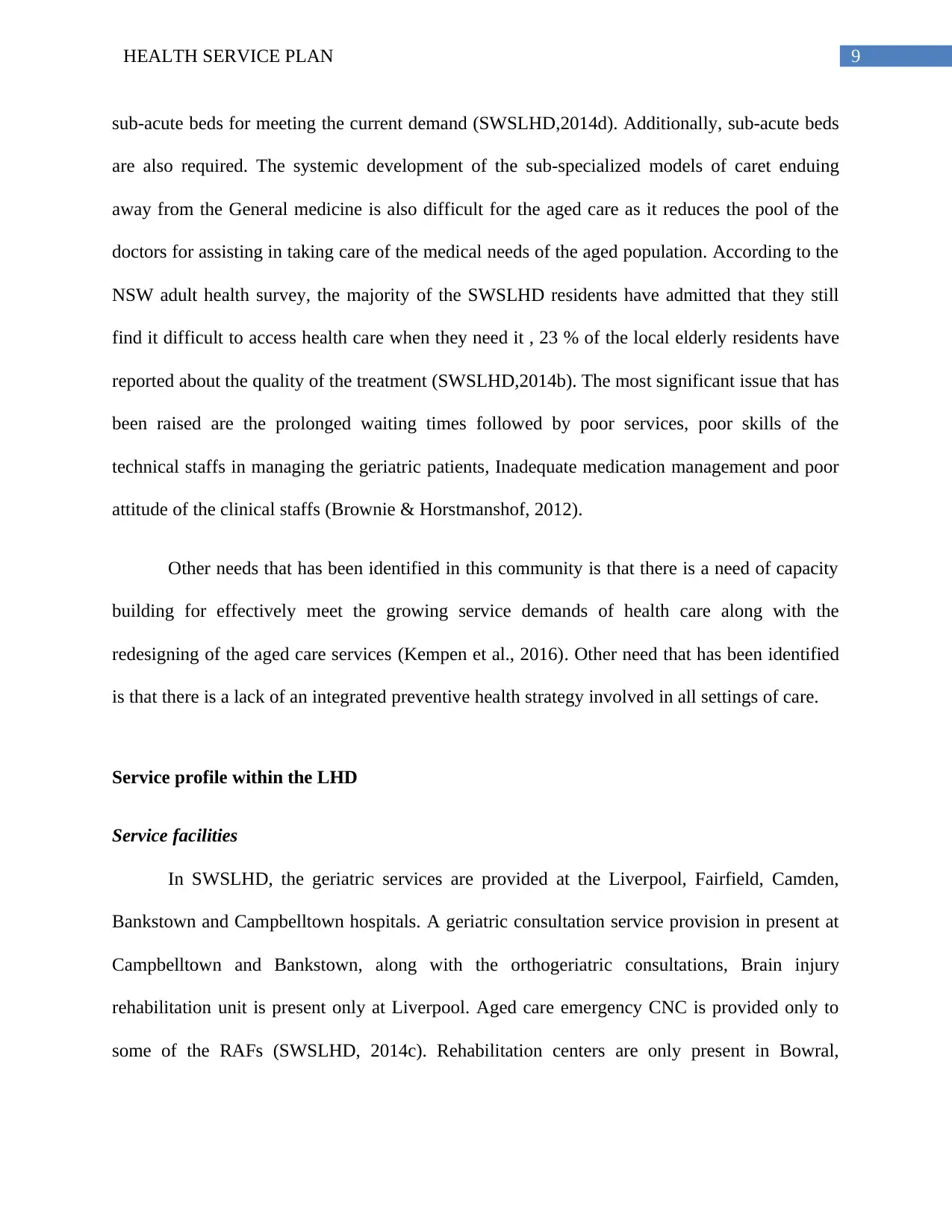
9HEALTH SERVICE PLAN
sub-acute beds for meeting the current demand (SWSLHD,2014d). Additionally, sub-acute beds
are also required. The systemic development of the sub-specialized models of caret enduing
away from the General medicine is also difficult for the aged care as it reduces the pool of the
doctors for assisting in taking care of the medical needs of the aged population. According to the
NSW adult health survey, the majority of the SWSLHD residents have admitted that they still
find it difficult to access health care when they need it , 23 % of the local elderly residents have
reported about the quality of the treatment (SWSLHD,2014b). The most significant issue that has
been raised are the prolonged waiting times followed by poor services, poor skills of the
technical staffs in managing the geriatric patients, Inadequate medication management and poor
attitude of the clinical staffs (Brownie & Horstmanshof, 2012).
Other needs that has been identified in this community is that there is a need of capacity
building for effectively meet the growing service demands of health care along with the
redesigning of the aged care services (Kempen et al., 2016). Other need that has been identified
is that there is a lack of an integrated preventive health strategy involved in all settings of care.
Service profile within the LHD
Service facilities
In SWSLHD, the geriatric services are provided at the Liverpool, Fairfield, Camden,
Bankstown and Campbelltown hospitals. A geriatric consultation service provision in present at
Campbelltown and Bankstown, along with the orthogeriatric consultations, Brain injury
rehabilitation unit is present only at Liverpool. Aged care emergency CNC is provided only to
some of the RAFs (SWSLHD, 2014c). Rehabilitation centers are only present in Bowral,
sub-acute beds for meeting the current demand (SWSLHD,2014d). Additionally, sub-acute beds
are also required. The systemic development of the sub-specialized models of caret enduing
away from the General medicine is also difficult for the aged care as it reduces the pool of the
doctors for assisting in taking care of the medical needs of the aged population. According to the
NSW adult health survey, the majority of the SWSLHD residents have admitted that they still
find it difficult to access health care when they need it , 23 % of the local elderly residents have
reported about the quality of the treatment (SWSLHD,2014b). The most significant issue that has
been raised are the prolonged waiting times followed by poor services, poor skills of the
technical staffs in managing the geriatric patients, Inadequate medication management and poor
attitude of the clinical staffs (Brownie & Horstmanshof, 2012).
Other needs that has been identified in this community is that there is a need of capacity
building for effectively meet the growing service demands of health care along with the
redesigning of the aged care services (Kempen et al., 2016). Other need that has been identified
is that there is a lack of an integrated preventive health strategy involved in all settings of care.
Service profile within the LHD
Service facilities
In SWSLHD, the geriatric services are provided at the Liverpool, Fairfield, Camden,
Bankstown and Campbelltown hospitals. A geriatric consultation service provision in present at
Campbelltown and Bankstown, along with the orthogeriatric consultations, Brain injury
rehabilitation unit is present only at Liverpool. Aged care emergency CNC is provided only to
some of the RAFs (SWSLHD, 2014c). Rehabilitation centers are only present in Bowral,
Paraphrase This Document
Need a fresh take? Get an instant paraphrase of this document with our AI Paraphraser
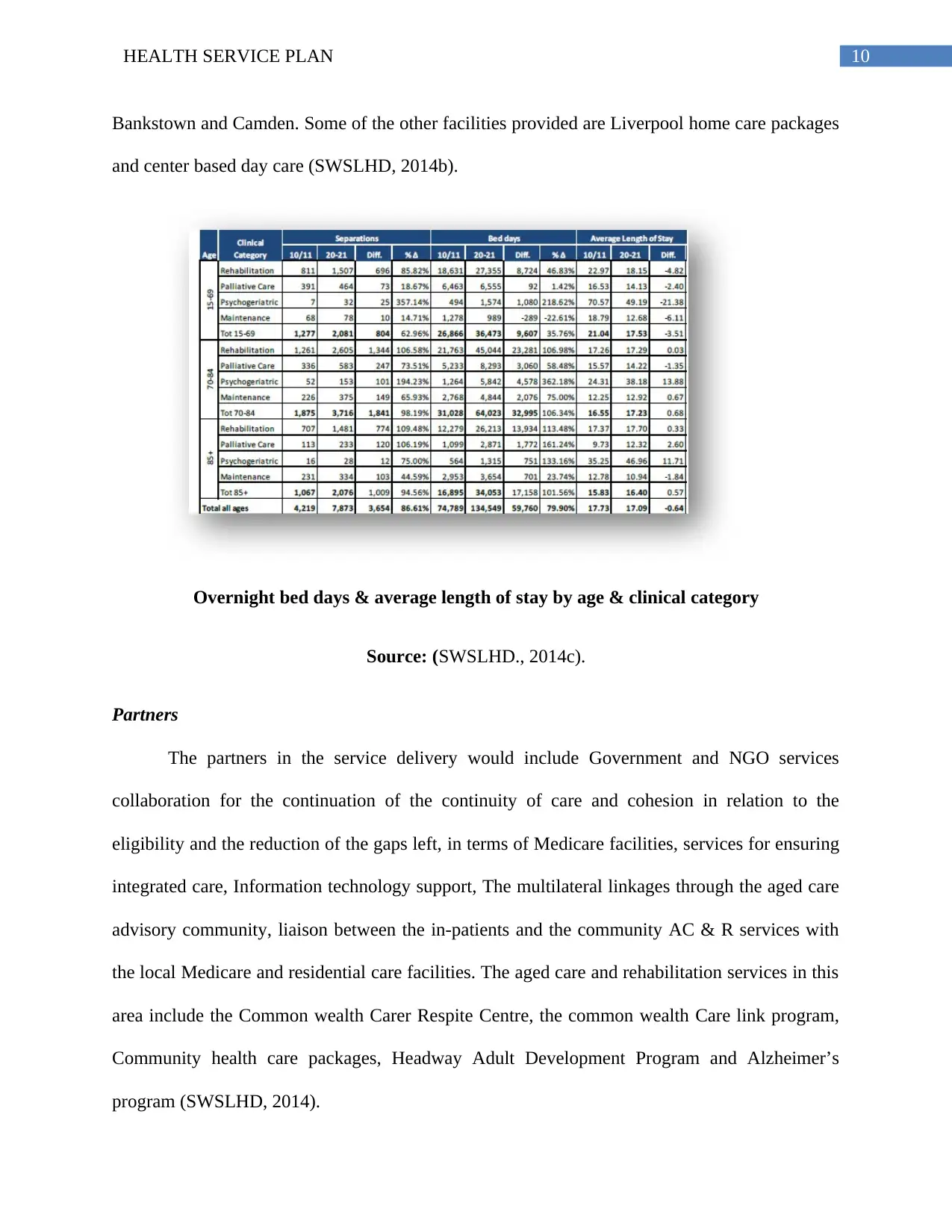
10HEALTH SERVICE PLAN
Bankstown and Camden. Some of the other facilities provided are Liverpool home care packages
and center based day care (SWSLHD, 2014b).
Overnight bed days & average length of stay by age & clinical category
Source: (SWSLHD., 2014c).
Partners
The partners in the service delivery would include Government and NGO services
collaboration for the continuation of the continuity of care and cohesion in relation to the
eligibility and the reduction of the gaps left, in terms of Medicare facilities, services for ensuring
integrated care, Information technology support, The multilateral linkages through the aged care
advisory community, liaison between the in-patients and the community AC & R services with
the local Medicare and residential care facilities. The aged care and rehabilitation services in this
area include the Common wealth Carer Respite Centre, the common wealth Care link program,
Community health care packages, Headway Adult Development Program and Alzheimer’s
program (SWSLHD, 2014).
Bankstown and Camden. Some of the other facilities provided are Liverpool home care packages
and center based day care (SWSLHD, 2014b).
Overnight bed days & average length of stay by age & clinical category
Source: (SWSLHD., 2014c).
Partners
The partners in the service delivery would include Government and NGO services
collaboration for the continuation of the continuity of care and cohesion in relation to the
eligibility and the reduction of the gaps left, in terms of Medicare facilities, services for ensuring
integrated care, Information technology support, The multilateral linkages through the aged care
advisory community, liaison between the in-patients and the community AC & R services with
the local Medicare and residential care facilities. The aged care and rehabilitation services in this
area include the Common wealth Carer Respite Centre, the common wealth Care link program,
Community health care packages, Headway Adult Development Program and Alzheimer’s
program (SWSLHD, 2014).
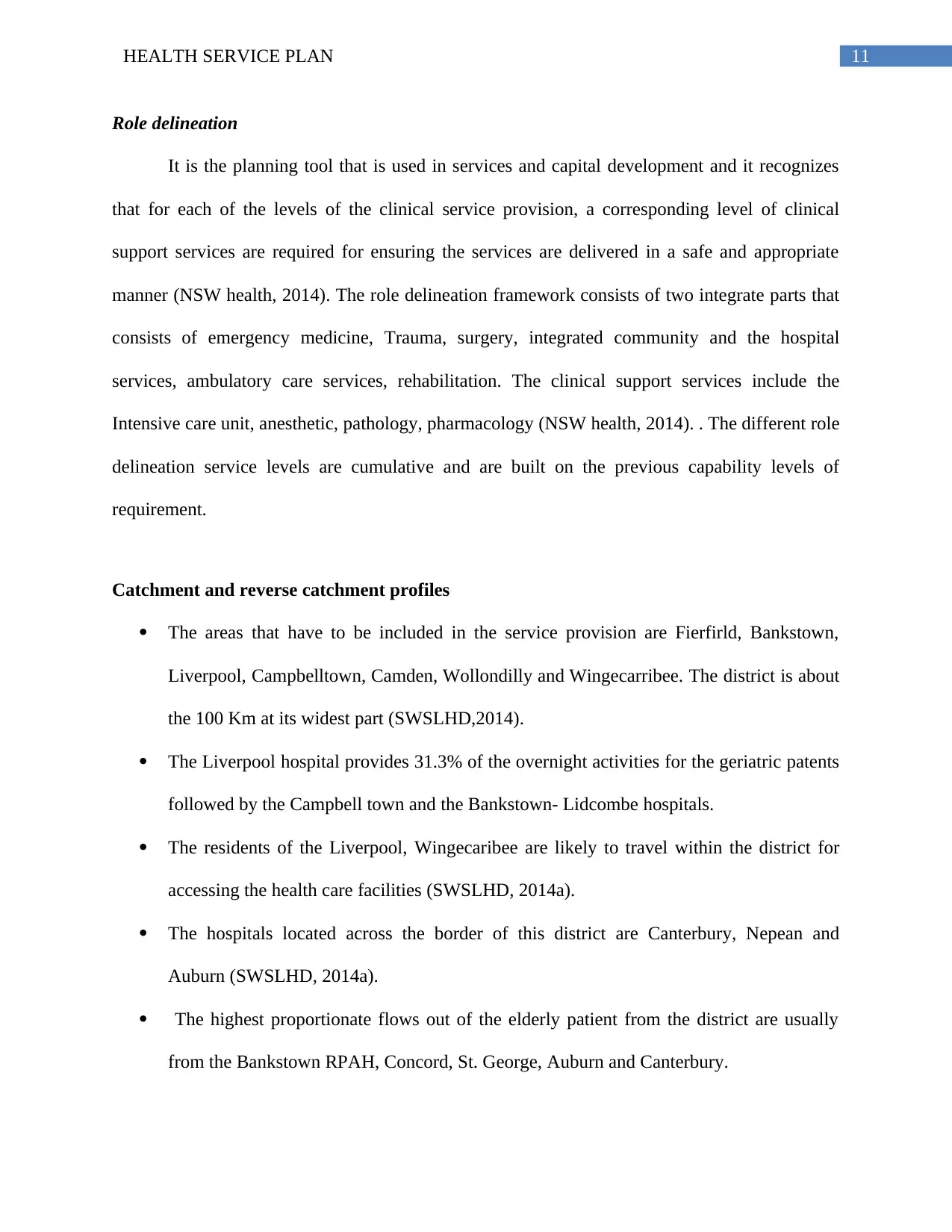
11HEALTH SERVICE PLAN
Role delineation
It is the planning tool that is used in services and capital development and it recognizes
that for each of the levels of the clinical service provision, a corresponding level of clinical
support services are required for ensuring the services are delivered in a safe and appropriate
manner (NSW health, 2014). The role delineation framework consists of two integrate parts that
consists of emergency medicine, Trauma, surgery, integrated community and the hospital
services, ambulatory care services, rehabilitation. The clinical support services include the
Intensive care unit, anesthetic, pathology, pharmacology (NSW health, 2014). . The different role
delineation service levels are cumulative and are built on the previous capability levels of
requirement.
Catchment and reverse catchment profiles
The areas that have to be included in the service provision are Fierfirld, Bankstown,
Liverpool, Campbelltown, Camden, Wollondilly and Wingecarribee. The district is about
the 100 Km at its widest part (SWSLHD,2014).
The Liverpool hospital provides 31.3% of the overnight activities for the geriatric patents
followed by the Campbell town and the Bankstown- Lidcombe hospitals.
The residents of the Liverpool, Wingecaribee are likely to travel within the district for
accessing the health care facilities (SWSLHD, 2014a).
The hospitals located across the border of this district are Canterbury, Nepean and
Auburn (SWSLHD, 2014a).
The highest proportionate flows out of the elderly patient from the district are usually
from the Bankstown RPAH, Concord, St. George, Auburn and Canterbury.
Role delineation
It is the planning tool that is used in services and capital development and it recognizes
that for each of the levels of the clinical service provision, a corresponding level of clinical
support services are required for ensuring the services are delivered in a safe and appropriate
manner (NSW health, 2014). The role delineation framework consists of two integrate parts that
consists of emergency medicine, Trauma, surgery, integrated community and the hospital
services, ambulatory care services, rehabilitation. The clinical support services include the
Intensive care unit, anesthetic, pathology, pharmacology (NSW health, 2014). . The different role
delineation service levels are cumulative and are built on the previous capability levels of
requirement.
Catchment and reverse catchment profiles
The areas that have to be included in the service provision are Fierfirld, Bankstown,
Liverpool, Campbelltown, Camden, Wollondilly and Wingecarribee. The district is about
the 100 Km at its widest part (SWSLHD,2014).
The Liverpool hospital provides 31.3% of the overnight activities for the geriatric patents
followed by the Campbell town and the Bankstown- Lidcombe hospitals.
The residents of the Liverpool, Wingecaribee are likely to travel within the district for
accessing the health care facilities (SWSLHD, 2014a).
The hospitals located across the border of this district are Canterbury, Nepean and
Auburn (SWSLHD, 2014a).
The highest proportionate flows out of the elderly patient from the district are usually
from the Bankstown RPAH, Concord, St. George, Auburn and Canterbury.
⊘ This is a preview!⊘
Do you want full access?
Subscribe today to unlock all pages.

Trusted by 1+ million students worldwide
1 out of 21
Related Documents
Your All-in-One AI-Powered Toolkit for Academic Success.
+13062052269
info@desklib.com
Available 24*7 on WhatsApp / Email
![[object Object]](/_next/static/media/star-bottom.7253800d.svg)
Unlock your academic potential
Copyright © 2020–2025 A2Z Services. All Rights Reserved. Developed and managed by ZUCOL.





